From Leaves to Beans: A Sip Through History
If you stroll down any British high street today, the aroma that hits you isn’t just the comforting scent of toasted crumpets or the faint perfume of a rose garden after rain—it’s coffee. The journey of the beloved ‘cuppa’ is a tale steeped in tradition, yet fizzing with modern reinvention. Once upon a time, tea reigned supreme in Britain, an emblem of civility and quiet afternoons, poured from porcelain pots in wood-panelled tearooms and bustling kitchen nooks alike. But somewhere between the rattling teacups and the birth of latte art, coffee began to steal centre stage. This shift from leaves to beans wasn’t just about taste; it reflected deeper social, economic, and cultural undercurrents swirling through British society. As globalisation blurred borders and urban life picked up its frenetic pace, cosmopolitan coffee houses sprouted across cityscapes like mushrooms after rain. Suddenly, the ritual of pausing for a brew was no longer tethered solely to tradition but became a badge of modernity—a new language for connection and creativity on the go. From Victorian parlours to sleek cafés with exposed brick and indie playlists, this evolution of the ‘cuppa’ captures more than changing drinks preferences; it tells a story of a nation reinventing itself, one espresso shot at a time.
Urban Cafés and Social Rituals
Wander down the streets of London or Manchester, and you’ll find yourself swept into a world where the aroma of freshly ground beans mingles with city air, and the clatter of ceramic cups forms the background score to urban life. The café scene in Britain’s cities has undergone a remarkable transformation in recent decades—a shift that speaks volumes about changing tastes, social habits, and what it means to take a break in modern Britain. Once upon a time, the humble tearoom was the chosen sanctuary for an afternoon chat; today, independent coffeehouses have muscled their way onto nearly every corner, from Shoreditch backstreets to the Northern Quarter’s bustling lanes.
These new-age cafés are far more than places to grab a caffeine fix. They’ve become communal living rooms—spaces where freelancers tap away at laptops, friends linger over flat whites, and locals catch up on neighbourhood news. The ritual of “going for a cuppa” now often means coffee rather than tea, reflecting not just a change in beverage preference but a broader cultural evolution. Where tea once symbolised comfort and tradition, coffee now stands for cosmopolitanism and creative energy—a subtle but significant shift in national mood.
| Traditional Tearoom | Modern Coffeehouse | |
|---|---|---|
| Atmosphere | Quiet, reserved | Bustling, dynamic |
| Beverage Focus | Tea varieties | Coffee specialities |
| Main Clientele | Elderly, families | Young professionals, creatives |
| Social Function | Afternoon tea, light conversation | Work meetings, casual gatherings |
This evolution isn’t just about what’s in your cup—it’s about how Britons connect. Urban cafés have redefined downtime: instead of formal parlours with dainty cups and doilies, we now gather in repurposed warehouses and indie roasteries, laptops open or newspapers sprawled. Coffeehouses are shaping not only our palates but also our patterns of interaction—making them the pulse points of contemporary British society.

3. The Language of the Cuppa: Words We Sip By
If you listen closely at a bustling London café or a windswept Manchester street corner, you’ll catch the hum of shifting vocabulary—proof that Britain’s heart is quietly recalibrating its caffeine compass. Once upon a time, “Fancy a brew?” was the gentle invitation passed between friends, neighbours, and colleagues alike. The word ‘brew’ itself was as British as drizzle on a Tuesday—evoking images of chipped mugs and biscuit tins. Yet now, it’s just as likely you’ll overhear someone breezily suggesting to “grab a flat white” or asking if anyone wants a “latte run.”
This change in linguistic weather tells its own story. The comforting murmur of “put the kettle on” has given way to the brisk efficiency of “I’ll pop out for coffee,” and with it, our conversations have taken on an urban, continental flair. Coffee’s rise isn’t just about what we’re drinking; it’s about how we’re talking about it—and by extension, ourselves. Terms like “Americano,” “macchiato,” and even “oat milk cortado” have crept into our daily parlance, elbowing out the humble “cuppa” and its classic English accompaniments.
Within offices and around kitchen tables, the language surrounding our hot drinks has become shorthand for lifestyle and aspiration. The phrase “coffee break” carries connotations of productivity and cosmopolitan cool, while “tea break” has started to feel nostalgic, even quaint. In British slang, “brew” still lingers in northern towns and older generations’ chats, but among young professionals in city centres, ordering a “flat white” signals not just your drink preference, but your cultural alignment—a nod to global trends swirling through local streets.
Our collective vocabulary is being redrawn with every order scribbled on a takeaway cup. Each new coffee shop—independent or chain—adds another dialect to the city’s soundscape. From cheeky banter over an espresso shot (“fancy a quick one?”) to earnest debates about single-origin beans, our words reflect how our rituals and identities are evolving in tandem with our taste buds.
Ultimately, this linguistic shift from tea to coffee is more than mere semantics. It’s a signpost of changing times—one where tradition meets trend at the bottom of a recyclable paper cup, where we sip not only for comfort but for connection to a wider world.
4. Pop Culture, Identity, and the Rising Steam of Coffee
If the British cuppa once conjured images of delicate porcelain and village fêtes, today’s cultural landscape finds itself saturated with the rich aroma of coffee. The transformation is no accident; pop culture has been the steam engine fuelling this shift, embedding coffee into the very fibre of youth identity from Shoreditch to Glasgow’s West End.
From Indie Screens to Instagram Stories
The indie film scene in Britain—think lo-fi romance flicks set in rain-soaked London or coming-of-age tales unfolding in Manchester’s backstreet cafés—often places coffee shops at the narrative heart. These spaces, brimming with battered sofas and exposed brick, become sanctuaries for characters to dream, debate, and discover themselves. Unlike tea, which evokes a certain nostalgia, coffee is framed as urban, creative, and ever so slightly rebellious—a drink for those sketching life on their own terms.
Coffee’s Social Currency on Social Media
Meanwhile, the rise of social media—especially Instagram—has further percolated coffee’s cool factor. The hashtag #latteart jostles with #flatwhite for attention as artfully poured drinks become aesthetic statements. Snaps of artisan cups against terrazzo tables are now badges of belonging to an in-the-know tribe. The coffee shop itself transforms from mere pitstop to lifestyle landmark; a place where every order signals taste as much as thirst.
Shaping Identity: Tea vs. Coffee Among Young Brits
| Aspect | Tea | Coffee |
|---|---|---|
| Pop Culture Associations | Traditional, nostalgic, rural | Modern, urban, creative |
| Social Media Presence | #afternoontea (classic) | #coffeelover #latteart (trend-driven) |
| Youth Perception | Comforting, a bit old-fashioned | Aspirational, expressive, individualistic |
| Spaces Linked To | Home kitchens, tearooms | Hipster cafés, co-working spaces |
| Lifestyle Symbolism | Simplicity & tradition | Ambition & modernity |
This cultural rebranding means that sipping a flat white isn’t just about caffeine—it’s a statement of intent. For younger generations navigating a rapidly shifting Britain, coffee has become shorthand for cosmopolitanism and creativity. Where tea once stood for civility and comfort, coffee now bubbles up as the drink of choice for those who see themselves as authors of their own narrative—one cup at a time.
5. The Local High Street: Chain Giants Vs. Independent Roasters
If you amble down any British high street these days, the aromatic haze of freshly ground beans is nearly inescapable. The coffee boom has reshaped urban landscapes from Edinburgh’s cobbled closes to London’s bustling boroughs, and at its heart is an ongoing tug of war: the omnipresent chain giants—think Costa, Starbucks, Caffè Nero—versus a new wave of independent roasters keen on reclaiming the soul of the ‘cuppa’.
The Rise of the Chains: Familiar Comforts and Fast Culture
The chains have made coffee accessible, turning it into an everyday ritual for commuters and students alike. Their ubiquity offers a certain comfort—predictable menus, familiar branding, and loyalty cards jingling in wallets across the country. For many Brits, grabbing a flat white before catching the morning train is as routine as checking the weather app for rain. The convenience of knowing exactly what you’ll get, wherever you are, reflects a modern Britain that values efficiency and global connectivity.
Independents: Craft, Community, and Character
Yet there’s a parallel narrative brewing. Independent coffee shops are flourishing too—quirky hideaways tucked between charity shops and florists, championing single-origin beans and latte art as intricate as a Turner sky. These spots aren’t just about caffeine; they’re community hubs where baristas remember your order and locals linger over novels or neighbourhood gossip. Here, the ‘cuppa’ returns to its roots: not merely a drink but a ritual laced with artistry and authenticity.
A Reflection of British Tastes and Dreams
This high street rivalry says much about evolving British aspirations. The chains echo a cosmopolitan sensibility—a desire to belong to something global, efficient, and accessible. Meanwhile, independents tap into nostalgia for village life, authenticity, and the romance of craftsmanship. Both are expressions of what it means to be British today: pragmatic yet yearning for individuality; open to the world but fiercely protective of local character.
The Future: Blending Tradition with Modernity
As coffee continues its reign over tea in public life, the landscape is unlikely to settle. Perhaps the future lies in collaboration rather than competition—chains learning from indie ethos, indies borrowing chain efficiency. Either way, Britain’s ‘cuppa’ has become more than just a beverage; it’s a canvas for shifting cultural tastes and ambitions.
Tea’s Resilience and Reinvention
Despite the meteoric rise of coffee culture across Britain, tea remains woven into the very fabric of daily life—a quietly enduring emblem of Britishness. The humble cuppa still holds court at kitchen tables, in bustling offices, and during cherished family gatherings, its gentle warmth offering both comfort and continuity. While flat whites and oat lattes may now dominate the high street, tea has not faded into quaint irrelevance; instead, it has evolved, adapting to the shifting tides of taste and time.
A Tradition That Refuses to Fade
The ritual of afternoon tea—delicate china, finger sandwiches, scones slathered with clotted cream—remains a cultural touchstone, a nod to heritage that continues to enchant locals and visitors alike. Even in modern homes, the simple act of “putting the kettle on” when friends or neighbours pop round signals hospitality and solidarity in a way no espresso shot quite can. Tea is still the drink of solace after bad news and celebration after good—a steadfast companion through life’s undulations.
Innovation on the Menu
Modern British cafés now feature inventive tea blends alongside their artisan coffees: smoky lapsang souchong, zesty chai lattes, even bubble teas for the adventurous palate. Artisans are reimagining classic brews with botanicals and native herbs, while eco-conscious brands champion loose-leaf and locally grown varieties. Far from being left behind, tea is writing itself into the new narrative of British taste—one where tradition meets creativity in every cup.
Community & Connection
Above all, tea’s resilience lies in its role as a social glue. It remains an integral part of community rituals—from charity fundraisers over endless mugs at the village hall to workplace “tea rounds” that spark conversation (and sometimes friendly debate about who takes sugar). In an age marked by digital pace and global flavours, tea anchors many Britons to a sense of place and shared identity. Perhaps this is why, even as coffee overtakes in trendiness, tea quietly endures: adaptable, unassuming, and always ready to bring people together.


